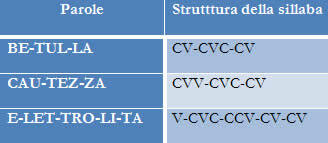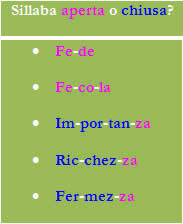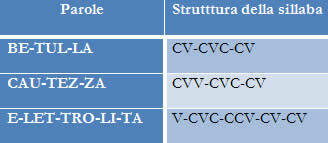Meaning:/ Meaning: * “Unità phonetica fondamentale cotituta da uno o più suoni che si pronounced con la stessa emisse di voce, puo’ essere formata da una vocale o da un dittongo, soli o accompagnati da una o più consonanti: divide, scomporre una parola in syllab; sillaba tonica, atone; parola di una sillaba, monosillabo; parola di due, tre, quattro sillabe, bisillabo, trisillabo, quadrisillabo.” / Fundamental phonetic unit, consisting of one or more sounds that are pronounced with the same voice emission and which can be formed by a vowel or a diphthong, alone or accompanied by one or more consonants: divide, decompose, a word in syllables; stressed, unstressed syllable; one-syllable word, monosyllable; two-, three-, four-syllable word, two-syllable, three-syllable, four-syllable word.
*Definition taken from the Dizionario Garzanti di Italiano.
Secondo gli authori Maurizio Dardano and Pietro Trifone alla loro grammatica “Italian Grammatica con nozione di linguistica”, I define the sillaba of the following way: “La sillaba It is close to the più piccola combinazioni phoniche in which I can consider the parole, and in which I share the same turn is necessary farlo, alla fine di a rigo, per floor hood.". / The authors Maurizio Dardano and Pietro Trifone, in the grammar “Grammatica Italiana con nozione di linguistica”, define the syllable as follows: The syllable is, therefore, the smallest of the phonic combinations, considered as a word, and which is divided as many times as necessary, until the end of the line to start writing on the line again successive.
Ogni comes back to the domandiamo eats richly the costruzione della sillaba, ossia, eats the loro struttura or eats scoprire if the sillaba is tightened/chiusa. In this matter, testo, vedrai di un moda generale, dei concetti and degli esempi sugli argomentilistati. / Sometimes we ask ourselves how to recognize the construction of the syllable, that is, how is its structure or how to find out if the syllable is open/closed. In this text, you will see in general some concepts and some examples about the related subjects.
Do not stop now... There's more after the advertising ;)
 Struttura della sillaba / Syllable structure
Struttura della sillaba / Syllable structure
The structure of the sillaba può darsi di diverse maniere. It is possibile esserci sillabe with formazione (CV, VC, CVC, CCV, V ecc.), dove C and V correspondingly correspondingly Consonant and Vocale. Vedi sotto degli esempi. / The structure of the syllable can happen in different ways. It is possible to have syllables with formation CV, VC, CVC, CCV, V, in which C and V correspond, respectively, to the consonant and the vowel. See below for some examples:

*Attention: Per capire the meaning of that parole che sleep alla tabella sopra, abbi un dictionario! / Attention: To understand the meaning of the words in the table above, get a dictionary!
Service that per scoprire the structure of a sillaba, of a way giusta, in a parola, it is important to know a po’ sulla sillabica division, south of this unparalleled argument pi ar avant. / Note that to figure out the structure of a syllable, correctly, in a word, it is necessary to know a little about syllabic division, but on this subject you will learn more forward.
 Cos’è sillaba tightens (releases) the chiusa (implicate)? / What is an open or closed syllable?
Cos’è sillaba tightens (releases) the chiusa (implicate)? / What is an open or closed syllable?
We can define the sillaba tightens that the finiscono for a vocal and the sillaba chiusa that the finiscono for a consonant. Vedi alcuni esempi! / We can call an open syllable that which ends with a vowel; and closed syllable, the one that ends with a consonant. See some examples!
Esempi: / Examples:

Isabela Reis de Paula
Brazil School Collaborator
Graduated in Letters with Qualification in Portuguese and Italian
By the Federal University of Rio de Janeiro - UFRJ

